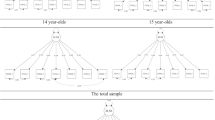Abstract
Concerns regarding construct bias in psychological assessment have been the subject of ongoing research for a half century. Little research has investigated the psychometric comparability of instruments designed to assess positive perceptions of individuals’ lives. The Multidimensional Students’ Life Satisfaction Scale (MSLSS), is based on a hierarchical factor structure that conceptualizes life satisfaction as an overall satisfaction that is subsumed by five domains believed to be important in youths’ lives: Family, Friends, School, Living Environment, and Self (Huebner in School Psychol Q 19:93–105, 1994). A Rasch measurement model was applied, rather than the typical approach of classical test theory such as factor analysis, to each domain to investigate measurement properties and determine equivalence across race at the item level. Results support a restructure of the rating scale categories due to the limited use of certain ratings and suggest revision of items that demonstrate differential item functioning across race. This study will aid in correct applications and proper interpretation of the scores reported for the MSLSS, as well as offering a methodological framework to apply to comparable psychological assessments.
Similar content being viewed by others
References
Adelman, H. S., Taylor, L., & Nelson, P. (1989). Minors’ dissatisfaction with their life circumstances. Child Psychiatry and Human Development, 20, 135–147.
Allen, J., & Walsh, J. R. (2000). A construct-based approach to equivalence: Methodologies for cross-cultural and multicultural personality assessment research. In R. Dana (Ed.), Handbook of multicultural/cross-cultural personality assessment. Mahwah, NJ: Lawrence Erlbaum Associates.
Andrich, D. (1978). A rating scale formulation for ordered response categories. Psychometrika, 43, 561–573.
Andrich, D. (1988). Rasch models for measurement. Sage University Paper Series on Quantitative Applications in the Social Sciences, Series No. 07-068. Beverly Hills: Sage Publications.
Bond, T., & Fox, C. (2001). Applying the Rasch model: Fundamental measurement in the Human Sciences. New Jersey: Lawrence Erlbaum Associates.
Campbell, A., Converse, P. E., & Rodgers, W. L. (1976). The quality of American life: Perceptions, evaluations and satisfactions. New York: Russell Sage Foundation.
Clarke, I. (2000). Extreme response style in cross-cultural research: An empirical investigation. Journal of Social Behavior and Personality, 15(1), 137–152.
Cowen, E. L. (1991). In pursuit of wellness. American Psychologist, 46, 404–408.
Cummins, R. A., Lau, A. L. D., Mellor, D., & Stokes, M. A. (2008). Encouraging governments to enhance the happiness of their nation: Step 1: Understand subjective wellbeing. Social Indicators Research, 91, 23–36.
Davern, M., Cummins, R. A., & Stokes, M. (2007). Subjective wellbeing as an affective-cognitive construct. Journal of Happiness Studies, 8, 429–449.
Diener, E. (2000). Subjective well-being: The science of happiness and a proposal for a national index. American Psychologist, 55, 34–43.
Diener, E., & Diener, M. (1996). Most people are happy. Psychological Science, 7(3), 181–185.
Diener, E., Suh, E. M., Lucas, R. E., & Smith, H. L. (1999). Subjective well-being: Three decades of progress. Psychological Bulletin, 125, 276–302.
Embretson, S. E. (1996). Item response theory models and inferential bias in multiple group comparisons. Applied Psychological Measurement, 20, 169–190.
Embretson, S. E., & Reise, S. P. (2000). Item response theory for psychologists. New Jersey: Lawrence Erlbaum Associates, Publishers.
Frisch, M. B., Clark, M. P., Rouse, S. V., Rudd, M. P., Paweleck, J., Greenstone, A., et al. (2003). Predictive validity and sensitivity to change in quality of life assessment and life satisfaction: Further studies of the Quality of Life Inventory of QOLI in mental health settings. In M. J. Sirgy, et al. (Eds.), Advances in quality of life theory and research (pp. 191–210). The Netherlands: Kluwer Academic Press.
Gilman, R., & Barry, J. (2003). Life satisfaction and social desirability among adolescents in a residential treatment setting: Changes across time. Residential Treatment for Children and Youth, 21, 19–42.
Gilman, R., & Huebner, E. S. (2000). Review of life satisfaction measures for adolescents. Behavior Change, 17, 178–195.
Gilman, R., & Huebner, E. S. (2003). A review of life satisfaction research with children and adolescents. School Psychology Quarterly, 18, 192–205.
Gilman, R., Huebner, E. S., & Laughlin, J. (2000). A first study of the Multidimensional Students’ Life Scale with adolescents. Social Indicators Research, 52, 135–160.
Greenspoon, P. J., & Saklofske, D. (2001). Toward an integration of subjective well-being and psychopathology. Social Indicators Research, 54, 81–108.
Gullone, E., & Cummins, R. A. (1999). The Comprehensive Quality of Life Scale: A psychometric evaluation with an adolescent sample. Behaviour Change, 16, 127–139.
Huebner, E. S. (1991). Initial development of the Students’ Life Satisfaction Scale. School Psychology International, 12, 231–240.
Huebner, E. S. (1994). Preliminary development and validation of a multidimensional life satisfaction scale for children. Psychological Assessment, 6, 149–158.
Huebner, E. S. (2004). Research and assessment of life satisfaction of children and adolescents. Social Indicators Research, 66, 3–33.
Huebner, E. S., & Gilman, R. (2002). An introduction to the Multidimensional Students’ Life Satisfaction Scale. Social Indicators Research, 60, 115–122.
Huebner, E. S., Laughlin, J. E., Ash, C., & Gilman, R. (1998). Further validation of the Multidimensional Students’ Life Satisfaction Scale. Journal of Psychological Assessment, 16, 118–134.
Huebner, E. S., Suldo, S. M., & Gilman, R. (2006). Life satisfaction. In G. Bear & K. Minke (Eds.), Children’s needs III: Development, prevention, and correction (pp. 357 – 368). Bethesda, MD: NASP.
Kan, C. C., Breteler, M. H. M., Van der Ven, A. H. G. S., & Zitman, F. G. (1998). An evaluation of the DSM-III-R and ICD-10 Benzodiazepine Dependence Criteria using Rasch modeling. Addiction, 93(3), 349–360.
Keyes, C. L. M. (2005). Mental illness and/or mental health? Investigating axioms of the complete state model of health. Journal of Consulting and Clinical Psychology, 73, 539–548.
Krueger, R. F., & Finger, M. S. (2001). Using item response theory to understand comorbidity among anxiety and unipolar mood disorders. Psychological Assessment, 13, 140–151.
Lewinsohn, P., Redner, J., & Seeley, J. (1991). The relationship between life satisfaction and psychosocial variables: New perspectives. In F. Strack, M. Argyle, & N. Schwartz (Eds.), Subjective well-being (pp. 193–212). New York: Plenum Press.
Linacre, J. M. (2004). Optimizing rating scale effectiveness. In E. V. Smith & R. M. Smith (Eds.), Introduction to Rasch measurement (pp. 258–278). Maple Grove, MN: JAM Press.
Maxwell, S., & Delaney, H. (1985). Measurement and statistics: An examination of construct validity. Psychological Bulletin, 97, 85–93.
McKnight, C. G., Huebner, E. S., & Suldo, S. M. (2002). Relationships among stressful life events, temperament, problem behavior, and global life satisfaction in adolescents. Psychology in the Schools, 39(6), 677–687.
Moors, G. (2003). Diagnosing response style behavior by means of a latent-class factor approach: Socio-demographic correlates of gender role attitudes and perceptions of ethnic discrimination reexamined. Quality & Quantity, 37, 277–302.
Ozer, D. J., & Reise, S. P. (1994). Personality assessment. Annual Review of Psychology, 45, 357–388.
Poortinga, Y. H. (1989). Equivalence of cross-cultural data: An overview of basic issues. International Journal of Psychology, 24, 737–756.
Sam, D. L. (1998). Predicting life satisfaction among adolescents from immigrant families in Norway. Ethnicity & Health, 3, 5–18.
Santor, D. A., & Ramsay, J. O. (1998). Progress in the technology of measurement: Applications of item response models. Psychological Assessment, 10, 345–359.
Scheuneman, J. D., & Bleistein, C. A. (1999). Item bias. In J. P. Keeves & G. N. Masters (Eds.), Advances in measurement in educational research and assessment (Vol. 18). NY: Pergamon.
Schmitz, M. F., & Baer, J. C. (2001). The vicissitude of measurement: A confirmatory factor analysis of the Emotional Autonomy Scale. Child-Development, 72, 207–219.
Selner-O’Hagan, M. B., Kindlon, D. J., Buka, S. L., Raudenbush, S. W., & Earls, F. J. (1998). Assessing exposure to violence in urban youth. Journal of Child Psychology and Psychiatry and Allied Disciplines, 39(2), 215–224.
Smith, R. M. (2004). Detecting item bias with the Rasch model. In E. V. Smith & R. M. Smith (Eds.), Introduction to Rasch measurement (pp. 258–278). Maple Grove, MN: JAM Press.
Smith, E. V., & Smith, R. M. (2004). Introduction to Rasch measurement. Maple Grove, MN: JAM Press.
Steel, P., & Ones, D. S. (2002). Personality and happiness: A national level analysis. Journal of Personality and Social Psychology, 83(3), 767–781.
Suldo, S. M., & Huebner, E. S. (2004). Does life satisfaction moderate the effects of stressful life events on psychopathological behavior during adolescence? School Psychology Quarterly, 19, 93–105.
Veenhoven, R. (1994). Is happiness a trait’? Test of the theory that a better society does not make people any happier. Social Indicators Research, 32, 101–160.
Welkenhuysen-Gybels, J., Billiet, J., & Cambre, B. (2003). Adjustment for acquiescence in the assessment of the construct equivalence of Likert-type score items. Journal of Cross-Cultural Psychology, 34, 702–722.
Wright, B. D., & Linacre, J. M. (1994). Reasonable mean-square fit values. Rasch Measurement Transactions, 8(3), 370.
Wright, B. D., & Masters, G. N. (1982). Rating scale analysis. Chicago, IL: MESA Press.
Wright, B. D., & Stone, M. H. (1979). Best test design. Chicago: MESA Press.
Author information
Authors and Affiliations
Corresponding author
Rights and permissions
About this article
Cite this article
Bradley, K.D., Cunningham, J.D. & Gilman, R. Measuring Adolescent Life Satisfaction: A Psychometric Investigation of the Multidimensional Students’ Life Satisfaction Scale (MSLSS). J Happiness Stud 15, 1333–1345 (2014). https://doi.org/10.1007/s10902-013-9478-z
Published:
Issue Date:
DOI: https://doi.org/10.1007/s10902-013-9478-z




